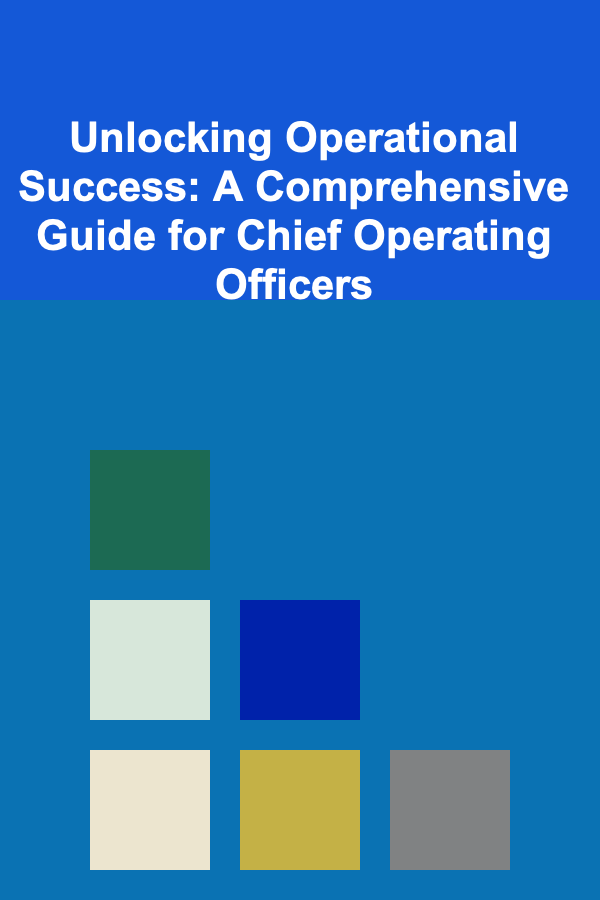
Unlocking Operational Success: A Comprehensive Guide for Chief Operating Officers
ebook include PDF & Audio bundle (Micro Guide)
$12.99$8.99
Limited Time Offer! Order within the next:

In today's rapidly changing business environment, the role of a Chief Operating Officer (COO) has never been more crucial. As the right-hand partner to the CEO, the COO is responsible for overseeing the operational aspects of the business, ensuring that the company runs efficiently, and enabling it to achieve its growth targets. However, operational success goes beyond maintaining smooth day-to-day operations---it involves continuously identifying and addressing challenges, optimizing processes, and implementing strategies that enhance productivity, quality, and profitability.
This comprehensive guide is designed to equip COOs with the key principles and actionable strategies they need to drive operational excellence. From optimizing business processes to leveraging technology for efficiency, this guide explores the multifaceted responsibilities that make a COO pivotal to unlocking operational success.
Establishing Operational Excellence Through Process Optimization
Operational excellence is foundational to the success of any business, and COOs are the champions of driving this culture throughout the organization. To unlock operational success, a COO must begin by identifying inefficiencies and redundancies in current processes and implement improvements that maximize efficiency without compromising quality.
Key Strategies for Process Optimization:
- Process Mapping and Analysis: Before implementing any changes, a COO should start by mapping out all core processes in the organization. Process mapping tools like Lucidchart or Microsoft Visio can help visualize workflows, identify bottlenecks, and highlight areas ripe for improvement.
- Adopt Lean Methodologies: Lean principles, which focus on reducing waste and increasing value, are crucial for achieving operational excellence. Implementing Lean practices such as continuous improvement (Kaizen) and Just-in-Time (JIT) can help streamline processes, improve quality, and reduce costs.
- Implement Six Sigma: For more complex processes that require stringent quality controls, Six Sigma provides a data-driven approach for process improvement. By focusing on reducing defects and variability, COOs can ensure the highest standards of performance and quality.
- Employee Involvement: Engaging employees in process improvement initiatives is critical. They are often the ones closest to the work and can provide invaluable insights into inefficiencies and potential solutions. Encourage a culture of open feedback where employees feel empowered to suggest process enhancements.
Tools and Resources:
- Process Mapping Tools: Lucidchart, Microsoft Visio
- Lean Methodology Tools: LeanKit, Trello (for managing Kanban workflows)
- Six Sigma Software: Minitab, SigmaXL
Harnessing Technology to Drive Efficiency
In the digital age, technology is a major enabler of operational success. As a COO, leveraging technology effectively can unlock tremendous improvements in efficiency, communication, and data-driven decision-making. By integrating the right tools, a COO can streamline operations, automate tasks, and enhance the overall operational flow.
Key Strategies for Leveraging Technology:
- Automation of Repetitive Tasks: Repetitive tasks such as invoicing, inventory management, and employee scheduling can be automated using software solutions. Tools like Zapier or Workato can automate workflows between apps and reduce the need for manual input.
- Enterprise Resource Planning (ERP) Systems: Implementing a comprehensive ERP system helps integrate all business functions---from finance to supply chain---into a single, unified platform. This centralized data repository improves efficiency, reduces errors, and enables real-time reporting. Popular ERP systems include SAP, Oracle, and NetSuite.
- Collaboration and Communication Tools: Efficient communication is key to operational success, and utilizing tools like Slack, Microsoft Teams, or Zoom can keep employees connected, no matter their physical location. These tools also enable real-time collaboration, ensuring that teams can respond quickly to changing circumstances.
- Data Analytics and Business Intelligence (BI): Data-driven decision-making is a cornerstone of operational success. BI tools such as Tableau, Power BI, and Google Data Studio allow COOs to analyze and visualize operational data, helping them make informed decisions that drive efficiency and growth.
Tools and Resources:
- Automation Tools: Zapier, Workato, Integromat
- ERP Systems: SAP, Oracle, NetSuite
- BI and Analytics Tools: Tableau, Power BI, Google Data Studio
Managing Supply Chain and Vendor Relationships
A key part of a COO's responsibility is managing the supply chain to ensure that products and services are delivered to customers on time and at the best possible cost. An efficient, reliable supply chain can provide a significant competitive advantage, whereas a poorly managed one can lead to delays, higher costs, and customer dissatisfaction.
Key Strategies for Supply Chain Management:
- Streamline Inventory Management: An inefficient inventory system can lead to stockouts or overstocking, both of which have negative financial consequences. Implementing a just-in-time inventory system can help reduce inventory costs and ensure the right products are available when needed.
- Supplier Relationship Management: Building strong relationships with suppliers is essential for ensuring quality, cost-effectiveness, and timely delivery. Regularly assess suppliers' performance, negotiate favorable terms, and foster a collaborative approach to problem-solving.
- Leverage Technology for Supply Chain Optimization: Modern supply chain management platforms, such as SAP Ariba or Oracle SCM, can help COOs track inventory, monitor supplier performance, and predict demand, ultimately improving supply chain efficiency.
- Risk Management and Contingency Planning: Disruptions in the supply chain, whether from natural disasters, political instability, or other unforeseen events, can severely impact operations. A COO must have contingency plans in place to mitigate these risks, including identifying backup suppliers and alternative shipping routes.
Tools and Resources:
- Inventory Management Systems: TradeGecko, NetSuite
- Supply Chain Management Platforms: SAP Ariba, Oracle SCM
- Risk Management Software: RiskWatch, Resolver
Financial Acumen for Operational Success
An essential component of operational success is managing the company's finances effectively. As the COO, you must work closely with the CFO to ensure the financial health of the organization while ensuring that the resources allocated for operations are being used efficiently.
Key Strategies for Financial Management:
- Cost Control and Budgeting: The COO must monitor operational costs closely and ensure that the company is operating within its budget. Identifying areas where costs can be reduced without impacting quality or productivity is a crucial responsibility.
- Revenue Growth through Operational Improvements: Operational improvements, such as enhancing supply chain efficiency or reducing lead times, often lead to direct financial benefits. By increasing the speed and effectiveness of operations, COOs can drive revenue growth while maintaining cost control.
- Financial Reporting and Metrics: Regularly monitoring and analyzing key financial metrics is essential. Key performance indicators (KPIs) such as gross margin, operational costs, and return on investment (ROI) should be tracked to ensure that the company remains on target.
- Capital Investment Decisions: When investing in new technology, equipment, or resources, the COO must assess the potential return on investment (ROI). Prioritize investments that will lead to long-term operational efficiencies or revenue growth.
Tools and Resources:
- Financial Management Software: QuickBooks, Xero, FreshBooks
- Cost Control Tools: Expensify, Concur
- Financial Reporting Tools: Tableau, Power BI
Cultivating a High-Performance Team
A high-performance team is the backbone of operational success. As COO, it's your responsibility to ensure that your team is motivated, well-equipped, and aligned with the company's strategic goals. Building and maintaining a productive, engaged workforce directly impacts the operational effectiveness of the organization.
Key Strategies for Team Management:
- Clear Leadership and Direction: COOs must communicate a clear vision to the team and ensure that everyone understands their role in achieving the company's objectives. Regularly align team goals with the broader strategic vision of the organization.
- Training and Development: A key part of building a high-performance team is providing ongoing training and development opportunities. Empower employees with the skills they need to excel, and create a culture that encourages continuous learning.
- Foster Collaboration and Accountability: Ensure that teams are working together effectively, with clear lines of accountability. Utilize project management tools like Asana or Trello to track progress and ensure that all team members are aligned.
- Employee Engagement and Retention: Engaged employees are more productive and more likely to stay with the company long-term. Implement regular feedback mechanisms, recognize achievements, and create an environment where employees feel valued and motivated.
Tools and Resources:
- Employee Engagement Platforms: Officevibe, TINYpulse, Gallup
- Project Management Tools : Asana, Trello, Monday.com
Navigating Risks and Crises
In today's unpredictable business world, crises and risks are inevitable. Whether it's a sudden economic downturn, a public relations issue, or a natural disaster, COOs must be prepared to navigate such situations swiftly and effectively to minimize damage and maintain business continuity.
Key Strategies for Risk and Crisis Management:
- Proactive Risk Management: Identify potential risks before they become crises. Conduct regular risk assessments to assess potential threats across operations, and develop mitigation strategies for each.
- Crisis Communication: In times of crisis, clear and transparent communication is vital. Ensure that your communication strategy is well-established, and that stakeholders---employees, customers, and investors---are kept informed with accurate and timely updates.
- Contingency Planning: Establish comprehensive contingency plans for various scenarios, including supply chain disruptions, cyberattacks, and financial crises. Having predefined action steps will allow the company to respond quickly and effectively.
- Post-Crisis Analysis: After a crisis has been managed, it's crucial to conduct a thorough analysis of how the situation was handled and what could have been done better. Learn from each crisis to improve future responses.
Tools and Resources:
- Risk Management Software: RiskWatch, Resolver
- Crisis Communication Tools: Everbridge, OnSolve
Conclusion
Operational success is a multifaceted goal that requires a wide range of skills and strategic insights. As the COO, your ability to optimize processes, leverage technology, manage resources, and lead your team effectively will directly impact the company's success. By focusing on these key areas and utilizing the right tools, COOs can unlock operational excellence and drive sustainable growth for the organization. The journey to operational success is ongoing, but with the right approach, COOs can guide their companies to thrive in an ever-evolving business landscape.

How to Create an Elegant Dining Room Lighting Setup
Read More
How to Extend the Life of Your Roof with Regular Inspections
Read More
How to Brew Dry-Hopped IPAs: A Deep Dive into the Crafting of Hop-Forward Beers
Read More
How to Build a Home Climbing Training Board
Read More
10 Tips for Proofreading Wedding Invitations to Avoid Mistakes
Read More
10 Tips for Building a High-Performing Scrum Team Culture
Read MoreOther Products

How to Create an Elegant Dining Room Lighting Setup
Read More
How to Extend the Life of Your Roof with Regular Inspections
Read More
How to Brew Dry-Hopped IPAs: A Deep Dive into the Crafting of Hop-Forward Beers
Read More
How to Build a Home Climbing Training Board
Read More
10 Tips for Proofreading Wedding Invitations to Avoid Mistakes
Read More